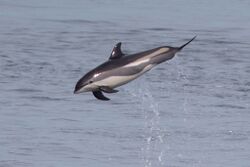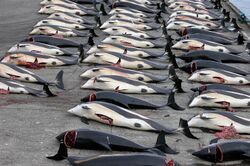Biology:Atlantic white-sided dolphin
| Atlantic white-sided dolphin | |
|---|---|

| |

| |
| Size compared to an average human | |
| Scientific classification | |
| Domain: | Eukaryota |
| Kingdom: | Animalia |
| Phylum: | Chordata |
| Class: | Mammalia |
| Order: | Artiodactyla |
| Infraorder: | Cetacea |
| Family: | Delphinidae |
| Genus: | Lagenorhynchus Gray, 1846 |
| Species: | L. acutus
|
| Binomial name | |
| Lagenorhynchus acutus (Gray, 1828)
| |

| |
| Atlantic white-sided dolphin range | |
The Atlantic white-sided dolphin (Lagenorhynchus acutus) is a distinctively coloured dolphin found in the cool to temperate waters of the North Atlantic Ocean.
Description

The dolphin is slightly larger than most other oceanic dolphins. It is just over a meter in length at birth, growing to about 2.8 m (9.2 ft) (males) and 2.5 m (8.2 ft) (females) at maturity.[3] It weighs 180–230 kg (400- 510 lb) once fully-grown.[3] Females reach sexual maturity at between 6 and 12 years, and males between 7 and 11 years.[4][5] The gestation period is 11 months and lactation lasts for about 18 months — both typical figures for dolphins.[3] Individuals are known to live for at least 17 years.[3]
The key distinguishing feature is the white to pale yellow patch found behind the dorsal fin of the dolphin on each side.[3] This colour variation is unique amongst the mixtures of white, greys and blues of other pelagic cetaceans.[3] The rest of the body's coloration is well demarcated: the chin, throat and belly are white; the flippers, dorsal fin and back are dark grey to black with the exception of the yellow patch; there is a further white patch below the dorsal fin, lying above a light grey stripe that runs from the beak, above the eye and down to the tail stock.[3]
Dolphin group sizes vary by location, with groups averaging 60 in number close to the Newfoundland shores, but rather smaller east of Iceland.[3] From the analysis of the stomach contents of stranded animals, fish such as herring and mackerel and squid appear to form the species' main diet.[3] The Atlantic white-sided dolphin is fairly acrobatic and keen to interact with boats, however it is not as wildly gregarious as the white-beaked and common dolphins.[3]
Geographic range and distribution
The species is endemic to the North Atlantic Ocean.[3] The distribution limits are Norwegian sea in the north east; Davis Strait in the north west; North Carolina in the south west and Celtic Sea in the south east (possible range extension to the Azores).[3] Areas of particularly high population density include the shores of Newfoundland and Cape Cod, the triangular area of sea between the United Kingdom , Iceland and Greenland and the North Sea.[6][7][8][9] In 2008, sightings of Atlantic white-sided dolphins as well as the melon-headed whale were documented in South Carolina after a few stranding had taken place in the area at the time.[10] The species tends to occur in continental shelf waters, around 100m depth.[11] They show preference toward areas with steep slopes and canyons.[12][13] They are more likely to be observed in cold, less saline waters but it is unclear whether it is due to preference or if these factors influence prey distribution.[14][15]
Behaviour
Foraging
The diet of Atlantic white-sided dolphins includes mainly herring, hake and squid.[3] However, they consume a large variety of prey including small mackerel and various bottom fish.[3] They have been observed to cooperatively hunt on the surface.[3] It has been suggested that larger groups split while feeding.[12]
Social Behaviour
Like all species of the dolphin family, Atlantic white-sided dolphins are very social animals. Often traveling in large pods and displaying aerial behaviors as they travel.[16] The group size varies from several dozen to several hundreds individuals with average size around 50.[17] However, there seems to be little relatedness between the members of the group. Studies in different parts of the distribution range found that individuals were mainly unrelated to each other.[18][19] Juveniles spend at least some time in separate groups than adults.[3] Atlantic white-sided dolphins jump and breach more frequently when in larger groups thus this behaviour might have a social context.[16] They have a wide vocal repertoire which includes squeals, whistles, clicks and buzzes.[17][20] It is suggested that vocalisation is used for communication as noise production increases during socialising.[20]
Despite being docile creatures, even known to interact with various species of cetacean in a nonviolent manner, most notably with the long-finned pilot whale (Globicephala melas),[21] they have also been known to display violent behavior towards harbor porpoises, attacking them until they eventually succumb to their wounds, a similar behavior observed in bottlenose dolphins.[22][23]
Migration
Atlantic white-sided dolphins do not undertake specific seasonal migration.[12] However, they do move within their home range following prey distribution.[12] For example, in the waters off eastern North America this species moves southwards in winter and spring.[3][8]
Reproduction
Most of the calves are born around June and July.[3] The gestation period is 11 months and lactation around 18 months.[3] The birth interval varies between 1–3 years.[11]
Females reach sexual maturity around the age of 6–12 years.[4] Males reach sexual maturity around 7–11 years.[5] The reproduction is most likely seasonal, beginning in February, as some studies have identified dormant testes in some males.[5]
Taxonomy
The Atlantic white-sided dolphin was named by John Edward Gray in 1828. The specific name acutus comes from the Latin for 'pointed' and refers to the sharply pointed dorsal fin.[3] It is traditionally placed in the genus Lagenorhynchus, but there is consistent molecular evidence that supports the Atlantic white-sided dolphin and the white-beaked dolphin as basal members of the family Delphinidae and not closely related.[24] It has therefore been proposed to move the Atlantic white-sided dolphin to its own genus, Leucopleurus.[25]
Population status
The estimations for the U.S. shelf and shelf-edge water suggest that the population size is about 300,000.[3] Additional 120,000 individuals have been estimated to spend summer in the Gulf of St.Lawrence.[3] In the eastern North America waters the numbers increase southwards in winter and spring in association with cold waters from the Gulf of Maine.[3] Two projects attempted to estimate the population trends - multinational Small Cetacean Abundance in the North Sea and Adjacent Waters (SCANS) survey project and the North Atlantic Sightings Survey (NASS). SCANS surveys, however, failed to produce species specific estimation as it combined both white-sided and white-beaked dolphins. NASS surveys did not indicate any population trends.
Threats

Whaling
Historically, Atlantic white-sided dolphins were killed in drives conducted from Norway and Newfoundland.[26] These have ceased in recent years, although they still occur to a lesser extent from the Faroe Islands, where the meat and blubber are in high regard as food.[27] Reported catches in the years vary, though individual years suddenly stand out, such as in 2002, where the number reported killed was 773,[28] and in 2017, when 488 were killed.[27] In September 2021, a large pod of 1,428 animals was herded in Skálafjördur and killed.[29]
| Year | No/yr | drive/yr | Year | No/yr | drive/yr | Year | No/yr | drive/yr | ||
|---|---|---|---|---|---|---|---|---|---|---|
| 1980 | 8 | 1 | 1993 | 377 | 6 | 2001 | 546 | 7 | ||
| 1983 | 10 | 1 | 1994 | 263 | 7 | 2002 | 773 | 10 | ||
| 1985 | 32 | 1 | 1995 | 157 | 4 | 2003 | 186 | 5 | ||
| 1986 | 185 | 4 | 1996 | 357 | 7 | 2004 | 333 | 5 | ||
| 1987 | 76 | 2 | 1997 | 350 | 10 | 2005 | 312 | 4 | ||
| 1988 | 603 | 4 | 1998 | 438 | 4 | 2006 | 622 | 8 | ||
| 1990 | 55 | 2 | 1998 | 438 | 4 | 2008 | 1 | 1 | ||
| 1992 | 47 | 3 | 2000 | 265 | 3 | 2009 | 171 | 5 |
Entanglement and by catch
Atlantic white-sided dolphins have also been killed in incidental catch situations in the fishing industry. Such occurrences have been reported in Canada, United States, United Kingdom and Ireland.[30] Between 1977 and 1988, 13 Atlantic white-sided dolphins were reported as being incidentally caught in the Northeastern United States by U.S fisheries observers, 11 of these in Mackerel fisheries.[31] They have also been reported to get caught in pelagic or near surface trawl or drift nets.[12][17]
Noise
Anthropogenic underwater noise is a potential disturbance to Atlantic white-sided dolphins as they use sounds to communicate and catch prey.[20] A survey done in the UK showed that the sighting rate of Atlantic white-sided dolphins declines when airguns were firing compared to when they were not.[20]
Pollution
Persistent organic pollutants (POPs) such as PCBs and organochlorine pesticides (e.g. DDT, DDE) and polybrominated diphenyl ether (PBDE) flame retardants have been identified in body tissues of Atlantic white-sided dolphins throughout their range.[7][32][33][34] Males had higher levels of PCBs suggesting that females pass some of the contamination to offspring during lactation[30]. Similarly to other species, studies have identified heavy metals in Atlantic white-sided dolphins including cadmium levels higher than in other dolphin species in southern latitudes.[35] The full effect of this contamination is currently unknown.
Conservation status
The International Union of the Conservation of Nature (IUCN) currently classifies Atlantic white-sided dolphins as Least Concern.[30]
The North and Baltic Sea populations of the Atlantic white-sided dolphin are listed on Appendix II [36] of the Convention on the Conservation of Migratory Species of Wild Animals (CMS). They are listed on Appendix II[36] as they have an unfavourable conservation status or would benefit significantly from international co-operation organised by tailored agreements.[37] These species of dolphin are known to fall victims to in a polluted environment, a study from 1997 confirmed that the British and Irish populations of Atlantic white-sided dolphins to succumb to these effects.[7][38] [clarification needed]
In addition, the Atlantic white-sided dolphin is covered by the Agreement on the Conservation of Small Cetaceans of the Baltic, North East Atlantic, Irish and North Seas (ASCOBANS).[39]
See also
- List of cetaceans
- Marine biology
References
- ↑ Hammond, P.S.Expression error: Unrecognized word "etal". (2008). "Lagenorhynchus acutus". IUCN Red List of Threatened Species 2008: e.T11141A3255721. doi:10.2305/IUCN.UK.2008.RLTS.T11141A3255721.en. https://www.iucnredlist.org/species/11141/3255721. Database entry includes a brief justification of why this species is of least concern.
- ↑ "Appendices | CITES". https://cites.org/eng/app/appendices.php.
- ↑ 3.00 3.01 3.02 3.03 3.04 3.05 3.06 3.07 3.08 3.09 3.10 3.11 3.12 3.13 3.14 3.15 3.16 3.17 3.18 3.19 3.20 3.21 3.22 Reeves, Randall (2008). Guide to Marine Mammals of the World. New York: National Audubon Society. pp. 398–401. ISBN 978-0375411410.
- ↑ 4.0 4.1 Sergeant (1980). "Life history and northwest Atlantic status of the Atlantic white-sided dolphin, Lagenorhynchus acutus". Cetology 37: 1–12.
- ↑ 5.0 5.1 5.2 Neuenhagen (2007). "Histology and morphometrics of testes of the white-sided dolphin (Lagenorhynchus acutus) in bycatch samples from the Northeastern Atlantic". Mammalian Biology 72 (5): 283–298. doi:10.1016/j.mambio.2006.10.008. https://link.springer.com/article/10.1016/j.mambio.2006.10.008.
- ↑ Schevill, W. E. (1956). "Lagenorhynchus acutus off Cape Cod". Journal of Mammalogy 37 (1): 128–129. doi:10.2307/1375559.
- ↑ 7.0 7.1 7.2 Mckenzie, C.; Rogan, E.; Reid, R.; Wells, D. (1997). "Concentrations and patterns of organic contaminants in Atlantic white-sided dolphins (Lagenorhynchus acutus) from Irish and Scottish coastal waters". Environmental Pollution 98 (1): 15–27. doi:10.1016/s0269-7491(97)00109-7. PMID 15093341. https://www.researchgate.net/publication/8611008.
- ↑ 8.0 8.1 Weinrich, Mason T.; Belt, Cynthia R.; Morin, David (April 2001). "Behavior and Ecology of the Atlantic White-Sided Dolphin (Lagenorhynchus Acutus) in Coastal New England Waters". Marine Mammal Science 17 (2): 231–248. doi:10.1111/j.1748-7692.2001.tb01268.x. ISSN 0824-0469. http://dx.doi.org/10.1111/j.1748-7692.2001.tb01268.x.
- ↑ Schevill, William E. (February 1956). "Lagenorhynchus acutus off Cape Cod". Journal of Mammalogy 37 (1): 128–129. doi:10.2307/1375559. ISSN 0022-2372. http://dx.doi.org/10.2307/1375559.
- ↑ Powell, J.W.; Rotstein, D.S.; Mcfee, W.E. (2012). "First Records of the Melon-Headed Whale (Peponocephala electra) and the Atlantic White-Sided Dolphin (Lagenorhynchus acutus) in South Carolina". Southeastern Naturalist 11 (1): 23–34. doi:10.1656/058.011.0102.
- ↑ 11.0 11.1 Waring (2006). "U.S. Atlantic and Gulf of Mexico marine mammal stock assessments – 2005". NOAA Technical Memorandum NMFS-NE 194: 346.
- ↑ 12.0 12.1 12.2 12.3 12.4 Gaskin (1992). "Status of the Atlantic white-sided dolphin, Lagenorhynchus acutus, in Canada". Canadian Field-Naturalist 106: 64–72.
- ↑ Palka (1997). "Summary of knowledge of white-sided dolphins (Lagenorhynchus acutus) from US and Canadian Atlantic waters". Report of the International Whaling Commission 47: 729–734.
- ↑ Selzer (1988). "The distribution of white-sided (Lagenorhynchus acutus) and common dolphins (Delphinus delphis) vs. environmental features of the continental shelf of the northeastern United States". Marine Mammal Science 4 (2): 141–153. doi:10.1111/j.1748-7692.1988.tb00194.x. https://onlinelibrary.wiley.com/doi/abs/10.1111/j.1748-7692.1988.tb00194.x.
- ↑ Doksæter (2008). "Distribution and feeding ecology of dolphins along the Mid-Atlantic ridge between Iceland and the Azores". Deep-Sea Research Part II: Topical Studies in Oceanography 55 (1–2): 243–253. doi:10.1016/j.dsr2.2007.09.009. Bibcode: 2008DSRII..55..243D. https://id.elsevier.com/as/authorization.oauth2?platSite=SD%2Fscience&scope=openid%20email%20profile%20els_auth_info%20els_idp_info%20urn%3Acom%3Aelsevier%3Aidp%3Apolicy%3Aproduct%3Ainst_assoc&response_type=code&redirect_uri=https%3A%2F%2Fwww.sciencedirect.com%2Fuser%2Fidentity%2Flanding&authType=SINGLE_SIGN_IN&prompt=login&client_id=SDFE-v3&state=retryCounter%3D0%26csrfToken%3D9e3a3712-7438-4cdf-9e19-58eba95a17d3%26idpPolicy%3Durn%253Acom%253Aelsevier%253Aidp%253Apolicy%253Aproduct%253Ainst_assoc%26returnUrl%3D%252Fscience%252Farticle%252Fpii%252FS0967064507002676%26uuid%3D4c419b9c-6047-4cdc-a874-05a5d05eb2d6%26prompt%3Dlogin%26cid%3Darp-a46a4357-0c53-4f9e-a90a-09a7a9001ce7.
- ↑ 16.0 16.1 Weinrich, M.T.; Belt, C.R.; Dorin, D. (2001). "Behavior And Ecology Of The Atlantic White-Sided Dolphin (Lagenorhynchus acutus) In Coastal New England Waters". Marine Mammal Science 17 (2): 231–248. doi:10.1111/j.1748-7692.2001.tb01268.x.
- ↑ 17.0 17.1 17.2 Reeves (1999). "Atlantic white-sided dolphin Lagenorhynchus acutus (Gray, 1828). In S. H. Ridgway and R. Harrison (eds.)". Handbook of Marine Mammals 6: 31–56.
- ↑ Mirimin (2011). "Insights into genetic diversity, parentage, and group composition of Atlantic white-sided dolphins (Lagenorhynchus acutus) off the West of Ireland based on nuclear and mitochondrial genetic markers". Journal of Heredity 102 (1): 79–87. doi:10.1093/jhered/esq106. PMID 21059883.
- ↑ Fernández (2016). "A genomewide catalogue of single nucleotide polymorphisms in white-beaked and Atlantic white-sided dolphins". Molecular Ecology Resources 16 (1): 266–276. doi:10.1111/1755-0998.12427. PMID 25950249.
- ↑ 20.0 20.1 20.2 20.3 Hamran (2014). "Distribution and vocal behavior of Atlantic white-sided dolphins (Lagenorhynchus acutus) in northern Norway". University of Nordland..
- ↑ Baraff, L. S.; Asmutis-Silvia, R. A. (1998). "Long-Term Association of an Individual Long-Finned Pilot Whale and Atlantic White-Sided Dolphins". Marine Mammal Science 14 (1): 155–161. doi:10.1111/j.1748-7692.1998.tb00700.x.
- ↑ Larrat, S.; Measures, L.; Stephane, L. (2012). "Short Note Rake Marks on a Harbor Porpoise (Phocoena phocoena) Calf Suggestive of a Fatal Interaction with an Atlantic White-Sided Dolphin (Lagenorhynchus acutus)". Aquatic Mammals 38 (1): 86–91. doi:10.1578/am.38.1.2012.86.
- ↑ Ross, H.M.; Wilson, B. (1996). "Violent interactions between Bottlenose dolphins and Harbour porpoises". Proceedings of the Royal Society B: Biological Sciences 263 (1368): 283–286. doi:10.1098/rspb.1996.0043. Bibcode: 1996RSPSB.263..283R.
- ↑ McGowen, Michael R; Tsagkogeorga, Georgia; Álvarez-Carretero, Sandra; dos Reis, Mario; Struebig, Monika; Deaville, Robert; Jepson, Paul D; Jarman, Simon et al. (2019-10-21). "Phylogenomic Resolution of the Cetacean Tree of Life Using Target Sequence Capture". Systematic Biology 69 (3): 479–501. doi:10.1093/sysbio/syz068. ISSN 1063-5157. PMID 31633766. PMC 7164366. https://doi.org/10.1093/sysbio/syz068.
- ↑ Vollmer, Nicole L.; Ashe, Erin; Brownell, Robert L.; Cipriano, Frank; Mead, James G.; Reeves, Randall R.; Soldevilla, Melissa S.; Williams, Rob (2019). "Taxonomic revision of the dolphin genus Lagenorhynchus" (in en). Marine Mammal Science 35 (3): 957–1057. doi:10.1111/mms.12573. ISSN 1748-7692. https://onlinelibrary.wiley.com/doi/abs/10.1111/mms.12573.
- ↑ NOAA. "Atlantic White-Sided Dolphin". U.S. Department of Commerce. https://www.fisheries.noaa.gov/species/atlantic-white-sided-dolphin#overview.
- ↑ 27.0 27.1 Corcoran, Kieran (13 May 2019). "Eco-campaigners took these grisly photos of whale and dolphin hunts in the Faroe Islands". Business Insider. Insider Inc.. https://www.businessinsider.com/whale-and-dolphin-hunts-in-faroe-islands-photographed-by-campaigners-2017-11.
- ↑ 28.0 28.1 Bloch, Dorete; Mikkelsen, Bjarni (26 February 2017). "Catch history and distribution of white- sided dolphin (Lagenorhynchus acutus) of the Faroe Islands / Veiðisøga og útbreiðsla av skjórutum springara (Lagenorhynchus acutus) í Føroyum". Fróðskaparrit - Faroese Scientific Journal 57: 190–198. doi:10.18602/fsj.v57i0.82.
- ↑ "Grindamenn: Drápið gekk ikki so illa". https://kvf.fo/greinar/2021/09/13/grindmenn-drapid-gekk-ikki-so-illa.
- ↑ 30.0 30.1 Hammond (2008). "Lagenorhynchus acutus". The IUCN Red List of Threatened Species.
- ↑ Waring, Gordon. "Incidental Take of Marine Mammals in Foreign Fishery Activities Off the Northeast United States, 1977-88". Fishery Bulletin. https://spo.nmfs.noaa.gov/sites/default/files/pdf-content/1990/882/waring.pdf.
- ↑ Weisbrod (2001). "Species, tissue and gender-related organochlorine bioaccumulation in white-sided dolphins, pilot whales and their common prey in the northwest Atlantic". Marine Environmental Research 51 (1): 29–50. doi:10.1016/S0141-1136(00)00032-5. PMID 11125702. Bibcode: 2001MarER..51...29W.
- ↑ Tuerk (2005). "Factors influencing persistent organic pollutant concentrations in the Atlantic white-sided dolphin (Lagenorhynchus acutus)". Environmental Toxicology and Chemistry 24 (5): 1079–1087. doi:10.1897/04-120R.1. PMID 16110985. https://zenodo.org/record/1236399.
- ↑ Montie (2009). "Organohalogen contaminants and metabolites in cerebrospinal fluid and cerebellum gray matter in short-beaked common dolphins and Atlantic white-sided dolphins from the western North Atlantic". Environmental Pollution 157 (8–9): 2345–2358. doi:10.1016/j.envpol.2009.03.024. PMID 19375836.
- ↑ Gallien (2001). "Cadmium-containing granules in kidney tissue of the Atlantic white-sided dolphin (Lagenorhyncus acutus) off the Faroe Islands". Comparative Biochemistry and Physiology 130 (3): 389–395. doi:10.1016/s1532-0456(01)00265-4. PMID 11701395. https://hal.archives-ouvertes.fr/hal-00911065v2/file/Gallien_et_al_2001_CBP.pdf.
- ↑ 36.0 36.1 "Appendix II " of the Convention on the Conservation of Migratory Species of Wild Animals (CMS). As amended by the Conference of the Parties in 1985, 1988, 1991, 1994, 1997, 1999, 2002, 2005 and 2008. Effective: 5 March 2009.
- ↑ "Convention on Migratory Species page on the Atlantic white-sided dolphin". http://www.cms.int/reports/small_cetaceans/data/l_acutus/l_acutus.htm.
- ↑ Tuerk, K. J. S.; Kucklick, J. R.; McFee, W. E.; Pugh, R. S.; Becker, P. R. (2005). "Factors influencing persistent organic pollutant concentrations in the Atlantic white-sided dolphin (Lagenorhynchus acutus)†". Environmental Toxicology and Chemistry 24 (5): 1079–1087. doi:10.1897/04-120r.1. PMID 16110985. https://zenodo.org/record/1236399.
- ↑ Official website of the Agreement on the Conservation of Small Cetaceans of the Baltic, North East Atlantic, Irish and North Seas
- Atlantic white-sided Dolphin by Frank Cipriano, Encyclopedia of Marine Mammals pp49–51 ISBN:0-12-551340-2
- National Audubon Society: Guide to Marine Mammals of the World ISBN:0-375-41141-0
- Encyclopedia of Marine Mammals ISBN:0-12-551340-2
External links
Wikidata ☰ Q216435 entry
 |


